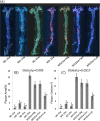Lubiprostone as a potential therapeutic agent to improve intestinal permeability and prevent the development of atherosclerosis in apolipoprotein E-deficient mice
- PMID: 31206525
- PMCID: PMC6576757
- DOI: 10.1371/journal.pone.0218096
Lubiprostone as a potential therapeutic agent to improve intestinal permeability and prevent the development of atherosclerosis in apolipoprotein E-deficient mice
Abstract
The interaction between atherosclerosis and commensal microbes through leaky gut syndrome (LGS), which is characterized by impaired intestinal permeability and the introduction of undesired pathogens into the body, has not been fully elucidated. Our aim was to investigate the potential role of a ClC-2 chloride channel activator, lubiprostone, which is reported to have beneficial effects on LGS, in the development of atherosclerosis in apolipoprotein E-deficient (ApoE-/-) mice. After a 15-week feeding period of a Western diet (WD), ApoE-/- mice were treated with a Western-type diet (WD) alone or WD with oral supplementation of lubiprostone for 10 weeks. This feeding protocol was followed by experimental evaluation of LGS and atherosclerotic lesions in the aorta. In mice with lubiprostone, in vivo translocation of orally administered 4-kDa FITC-dextran was significantly improved, and RNA expression of the epithelial tight junction proteins, Zo-1 and occludin, was significantly up-regulated in the ileum, compared to the WD alone group, suggesting a possible reversal of WD-induced intestinal barrier dysfunction. As a result, WD-induced exacerbation of atherosclerotic lesion formation was reduced by 69% in longitudinally opened aortas and 26% in aortic root regions. In addition, there was a significant decrease in circulating immunoglobulin level, followed by an attenuation of inflammatory responses in the perivascular adipose tissue, as evidenced by reduced expression of pro-inflammatory cytokines and chemokines. Lubiprostone attenuates atherosclerosis by ameliorating LGS-induced inflammation through the restoration of the intestinal barrier. These findings raise the possibility of targeting LGS for the treatment of atherosclerosis.
Conflict of interest statement
The authors have declared that no competing interests exist.
Figures







Similar articles
-
Pharmaceutical Activation or Genetic Absence of ClC-2 Alters Tight Junctions During Experimental Colitis.Inflamm Bowel Dis. 2015 Dec;21(12):2747-57. doi: 10.1097/MIB.0000000000000550. Inflamm Bowel Dis. 2015. PMID: 26332307
-
Chronic stress and intestinal permeability: Lubiprostone regulates glucocorticoid receptor-mediated changes in colon epithelial tight junction proteins, barrier function, and visceral pain in the rodent and human.Neurogastroenterol Motil. 2019 Feb;31(2):e13477. doi: 10.1111/nmo.13477. Epub 2018 Oct 4. Neurogastroenterol Motil. 2019. PMID: 30284340 Free PMC article.
-
Edgeworthia gardneri (Wall.) Meisn protects against HFD-induced murine atherosclerosis through improving gut microbiota-mediated intestinal barrier integrity.Atherosclerosis. 2025 Apr;403:119132. doi: 10.1016/j.atherosclerosis.2025.119132. Epub 2025 Feb 21. Atherosclerosis. 2025. PMID: 40015156
-
Berberine treatment increases Akkermansia in the gut and improves high-fat diet-induced atherosclerosis in Apoe-/- mice.Atherosclerosis. 2018 Jan;268:117-126. doi: 10.1016/j.atherosclerosis.2017.11.023. Epub 2017 Nov 24. Atherosclerosis. 2018. PMID: 29202334
-
Western diet components that increase intestinal permeability with implications on health.Int J Vitam Nutr Res. 2024 Jun;94(5-6):405-421. doi: 10.1024/0300-9831/a000801. Epub 2023 Nov 27. Int J Vitam Nutr Res. 2024. PMID: 38009780 Review.
Cited by
-
Endotoxins and Non-Alcoholic Fatty Liver Disease.Front Endocrinol (Lausanne). 2021 Oct 29;12:770986. doi: 10.3389/fendo.2021.770986. eCollection 2021. Front Endocrinol (Lausanne). 2021. PMID: 34777261 Free PMC article. Review.
-
Intestinal Barrier Dysfunction, LPS Translocation, and Disease Development.J Endocr Soc. 2020 Feb 20;4(2):bvz039. doi: 10.1210/jendso/bvz039. eCollection 2020 Feb 1. J Endocr Soc. 2020. PMID: 32099951 Free PMC article.
-
Intestinal fatty acid-binding protein mediates atherosclerotic progress through increasing intestinal inflammation and permeability.J Cell Mol Med. 2020 May;24(9):5205-5212. doi: 10.1111/jcmm.15173. Epub 2020 Mar 27. J Cell Mol Med. 2020. Retraction in: J Cell Mol Med. 2022 Feb;26(3):955. doi: 10.1111/jcmm.17151. PMID: 32220004 Free PMC article. Retracted.
-
The Role of Leaky Gut in Nonalcoholic Fatty Liver Disease: A Novel Therapeutic Target.Int J Mol Sci. 2021 Jul 29;22(15):8161. doi: 10.3390/ijms22158161. Int J Mol Sci. 2021. PMID: 34360923 Free PMC article. Review.
-
Sivelestat Alleviates Atherosclerosis by Improving Intestinal Barrier Function and Reducing Endotoxemia.Front Pharmacol. 2022 Apr 4;13:838688. doi: 10.3389/fphar.2022.838688. eCollection 2022. Front Pharmacol. 2022. PMID: 35444551 Free PMC article.
References
Publication types
MeSH terms
Substances
LinkOut - more resources
Full Text Sources
Medical
Research Materials
Miscellaneous

